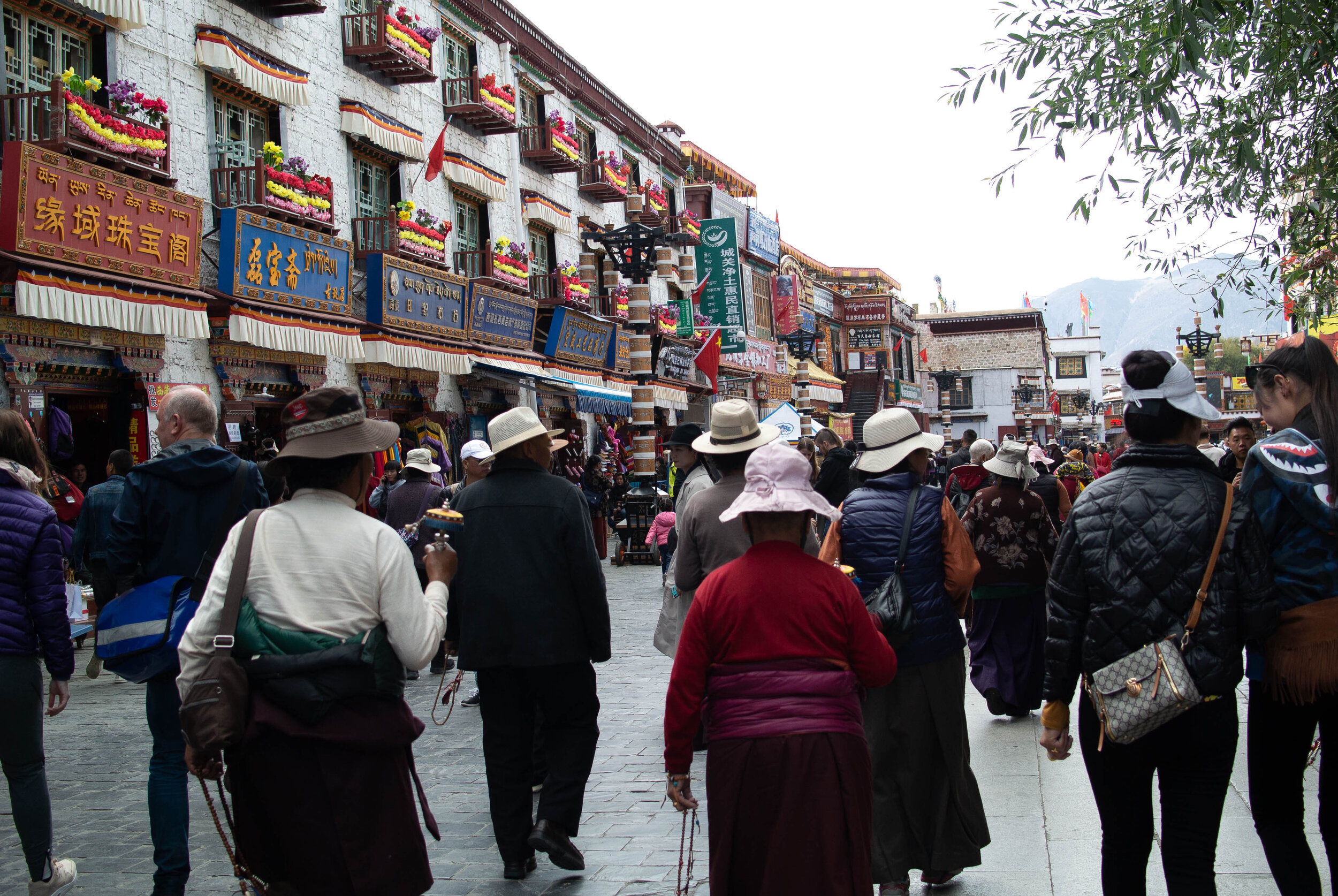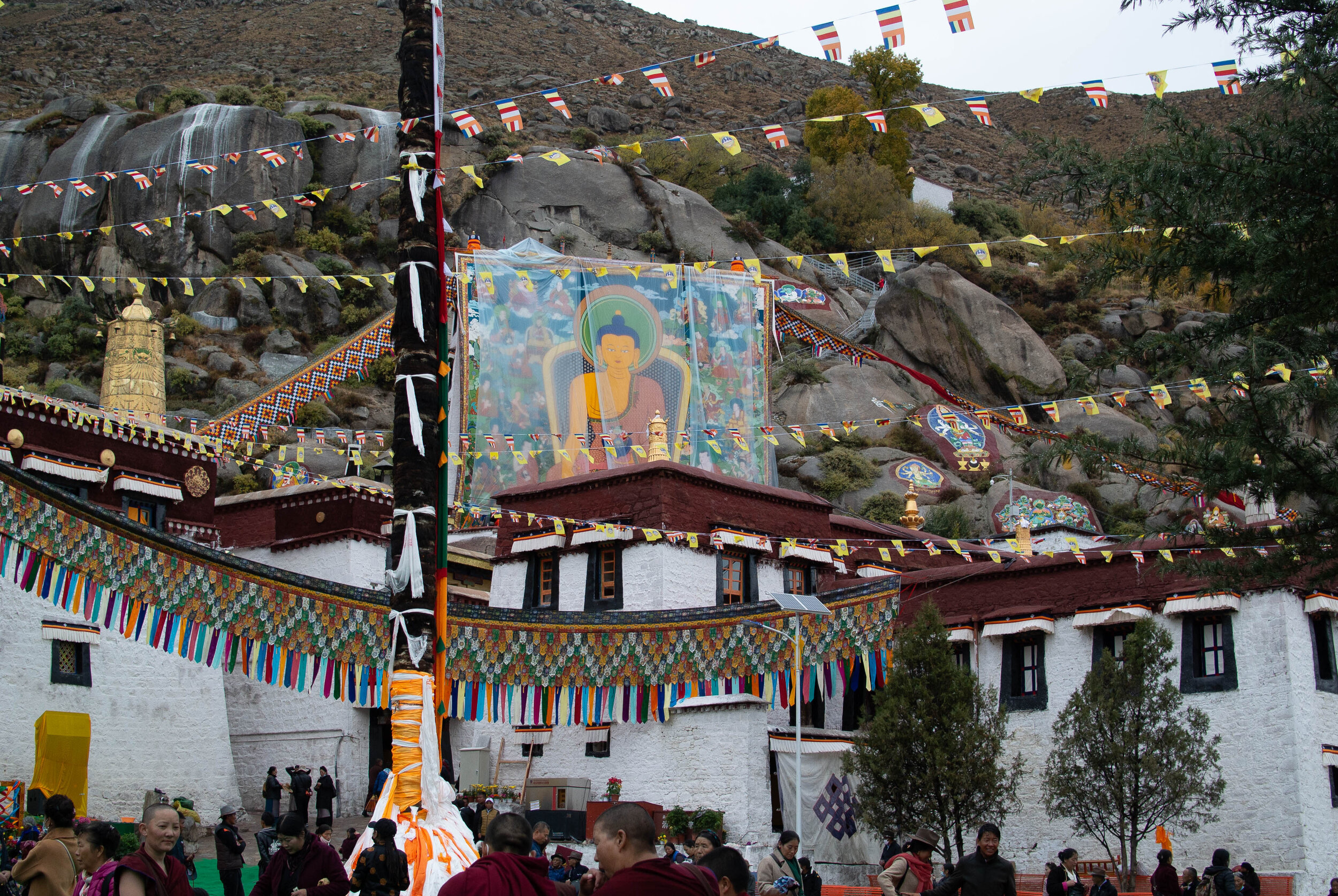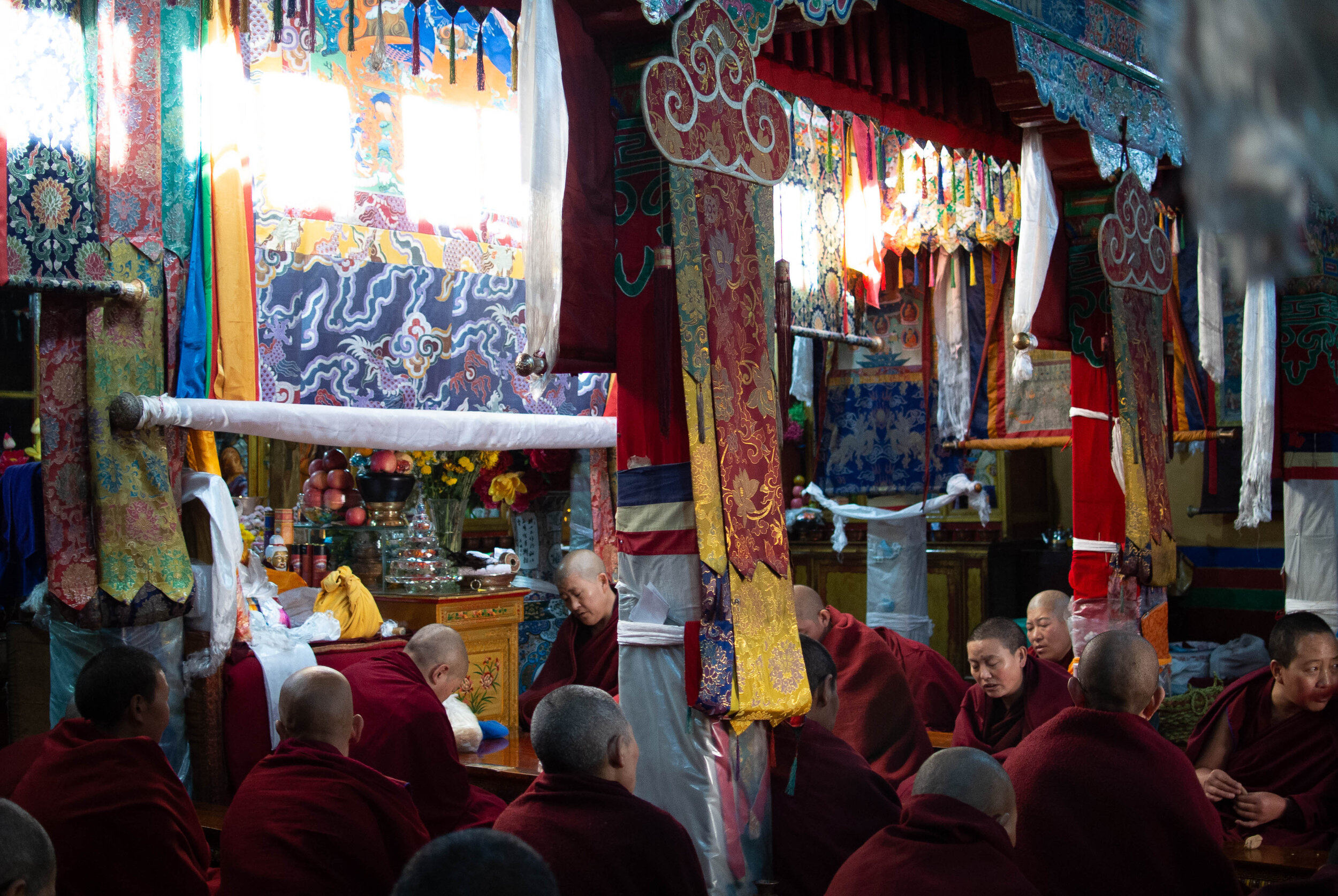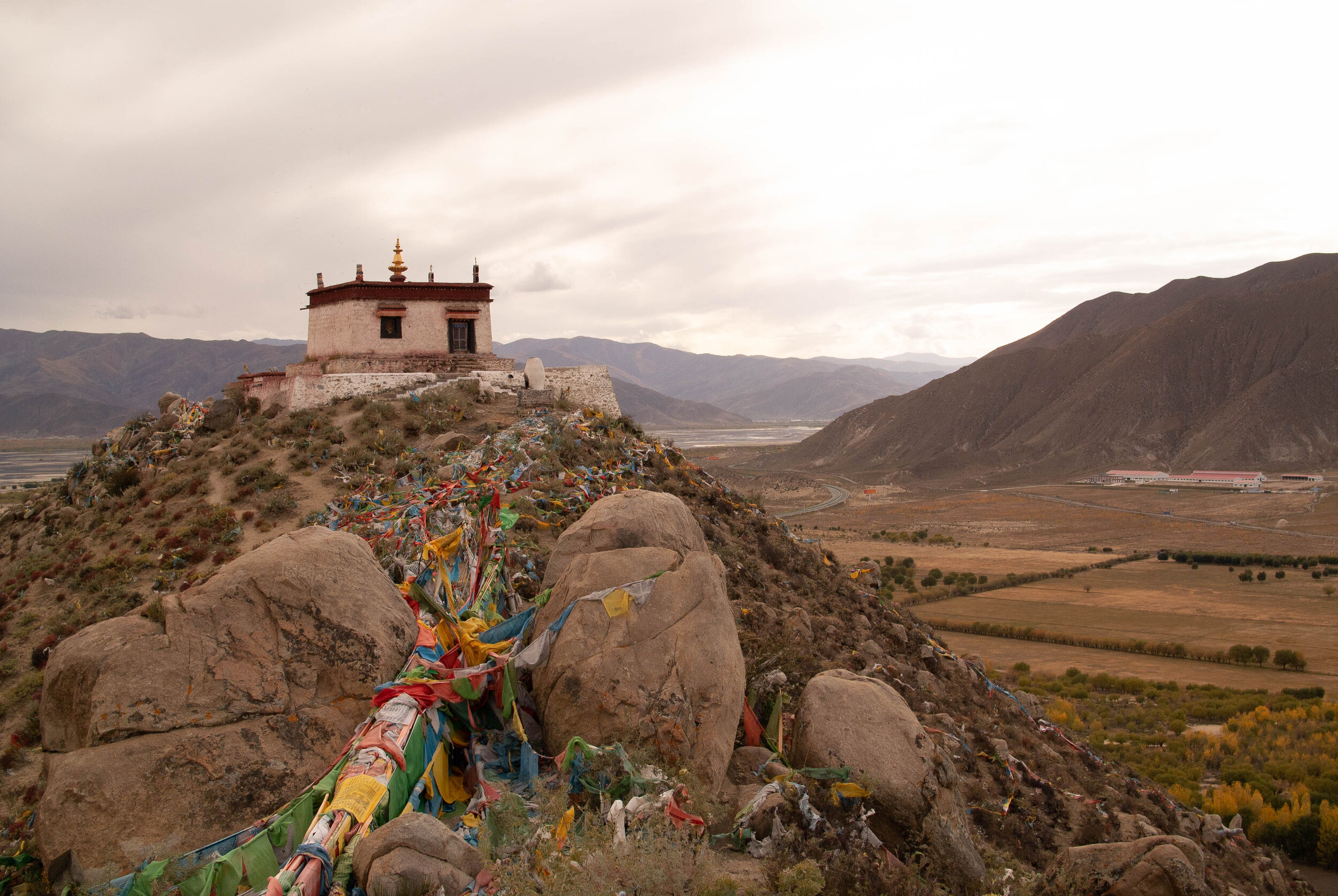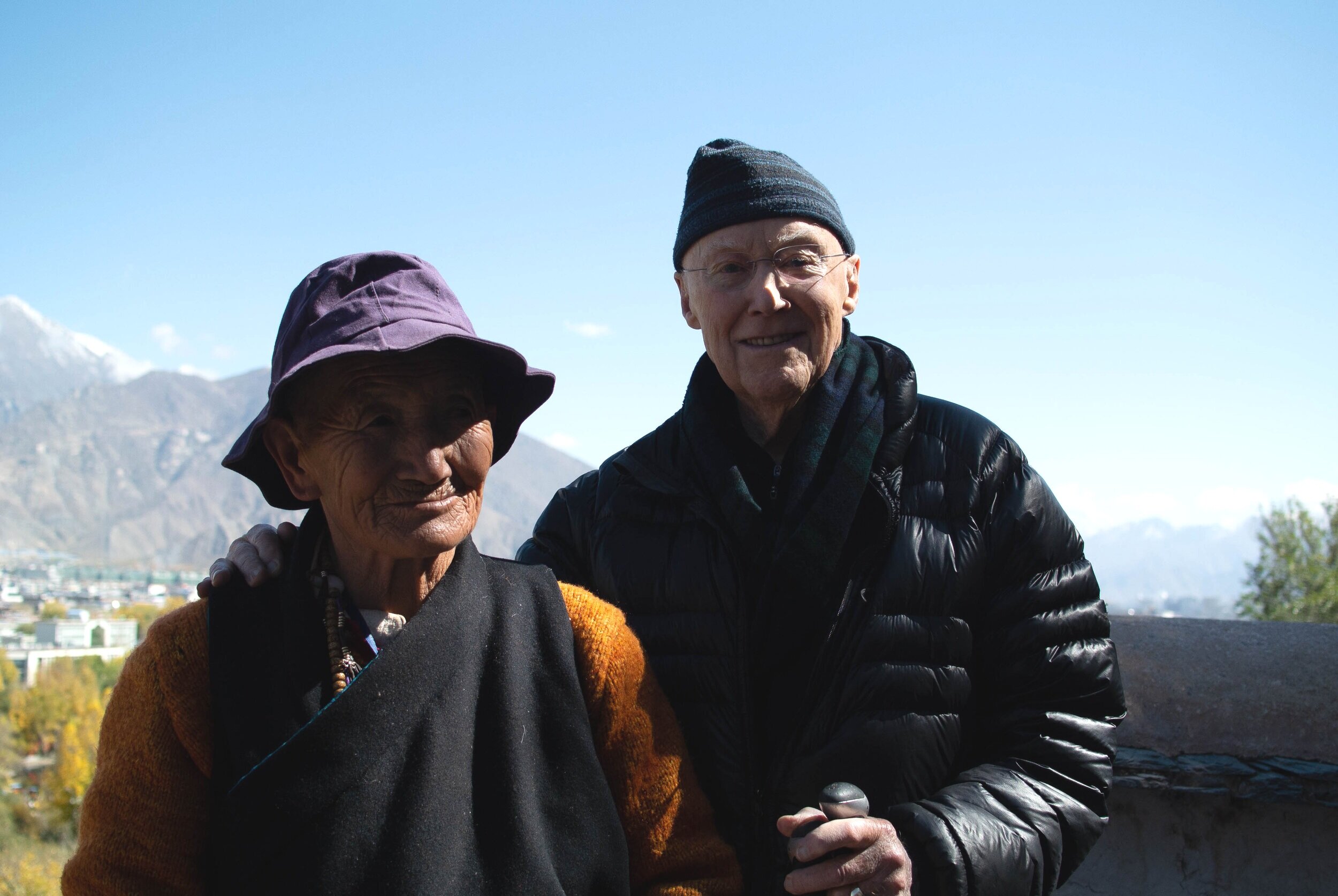Our three-generational quartet, aged twenty-nine to ninety-two, received four visas for Tibet at our airport Beijing hotel less than twenty-four hours before our scheduled flight to Lhasa. We could hardly believe it, we were going to Tibet after so many hurdles.
In front of the Potala Palace, built in the 7th century and then rebuilt in the 17th century, this masterpiece of Tibetan architecture, was home to the Dalai Lamas and Tibetan government from the 17th century until 1959 when the present Dalai Lama escaped to India.
Bill, my stepfather, and my daughter, Ariel, walking down the wet and slippery slope on the backside of the Potala Palace.
Our travels through Tibet climbed up and down—stairs and mountains, from thrilling sights to chilling realities. The first three shocks upon arrival:
Three fighter jets sat near the terminal at the Lhasa airport. Military presence we would learn is everywhere.
Our guide pointed to the two recording devices on the dashboard of the vehicle we would be traveling in for the next ten days. We needed to always be aware that what we were saying, not only in the car, but anywhere, might be overheard and reported.
Tibetans cannot have passports. No Tibetan person can leave the country.
Blase, my partner, and I send prayers by way of the smoke from burning juniper at a high pass above Lhasa.
Lhasa is seemingly undergoing more construction than any other city in the world. In downtown Lhasa, the snowcapped mountains are partially obscured by high-rise apartment buildings. The construction is primarily for the Chinese who are moving into Tibet. The population is changing. Tibet now has an estimated population of about 6 million Tibetans and 7.5 million Chinese settlers. The apartments are affordable only if you have a government job.
For five days, we stayed in the old part of Lhasa from where we could walk to monasteries, temples, nunneries, noodle shops, teahouses, and explore the narrow streets of old Tibet. We joined the devoted pilgrims walking clockwise around the Barkhor Circuit, Lhasa’s most important pilgrimage Kora.
The Barkhor Kora, an everyday happening.
This walk takes you around the Jokhang, one of Tibet’s oldest temples. Pilgrims make the circuit multiple times, some walk, some do full body bows. Others stop at the plaza in front of the Jokhang, roll out their prostration mat, and do a hundred, or a thousand full prostrations, sliding out on their gloved hands or using wooden blocks strapped to their hands, to extend their arms fully out beyond their head, belly flat on the ground.
Before sunrise prostrations.
Inside the darkness of the old Jokhang pilgrims are moving always in a clockwise direction, making offerings to colorful thangkas and sculptures of Buddhas, deities, demons, and kings. Butter lamps burn, silver bowls of water glisten, cans of beer (some protectors favor beer) along with fruit, money, and yak butter decorations are packed into every nook and cranny. Gongs and drums, wood and cloth, bright colors, meditation cushions piled with burgundy meditation robes, people jostling, hurrying, determined to complete their rounds, Tibetan Buddhism is practiced here by Tibetans everyday.
We arrived at Sera monastery during celebrations for their six-hundred year anniversary. The road was closed. The Police were limiting the number of people. Following our guide, we started walking to see if there was another way to enter and saw people slipping through a hole in a fence and running across a yak field. We followed at the fastest clip we could manage on day one at 12,000 feet, avoiding the entrance road and entering further up towards the monastery. Our timing worked. Another ten minutes and this alternate route would have been closed. The monastery was filled with pilgrims from all over Tibet in colorful traditional clothing, mala beads in hand, making offerings and chanting, We followed a group of people to see the Thangka unveiled for the occasion, about three hundred feet in length and hanging over a slap of flat rock, covered in plastic because of the rain.
Monasteries are traditionally built into the hillsides, and above many of them are rocky paths leading to caves where monks, and Dalai Lamas, and yogis like Milarepa and Guru Rinpoche once meditated for years at a time.
During the cultural revolution ninety-five percent of the monasteries were destroyed, but now the Central Government is rebuilding them, though limiting the number of monks who can live at each one. Tibetan families historically sent at least one son to become a monk, but today, you need to be approved by the Central Government. Monasteries were the principal sites of resistance—the government wants to make sure that this doesn’t happen again. The Police have a convincing presence at the large monasteries, the head Abbot is appointed by the Central Government. I imagine even in a monastery one must be careful with one’s opinions.
After visiting Gangden Monastery, a complex with some fifty buildings that was first destroyed during the 1959 Tibetan Uprising and then reduced to rubble during the 1966-67 Cultural Revolution, the brutality of the deaths kept me awake all night weeping. Throughout the trip I worried that we could be arrested for our sympathy for the Tibetans or that we would put our guide at risk.
Nuns at morning service in the main assembly hall at the Nunnery in Chimpuk.
In spite of decades of persecution, the Tibetan people are among the most spiritually devoted people I have encountered. There was never a monastery, nunnery, or temple without pilgrims. In the streets, it seemed like everyone carried their mala beads, even while shopping. I wondered if it was prayer or a devotional peaceful resistance? We visited a small monastery in Lhasa that was completely packed with worshipers. People covered every inch of the courtyard and chapels.
We visited Samye, the first Buddhist monastery in Tibet, climbing the hill nearby to have a view of its mandala pattern and take in the fields and bare mountains.
The hill above Samye Monastery.
We learned the local houses around Samye will soon be razed to the ground to clean up the area around the monastery. These local people will be given housing in several apartment buildings. How will they remain farmers and herders? Where will the cows return to at night?
An ancient world is changing. Roads are being built throughout the country. In the river valleys the Central Government has planted hundreds of thousands of trees. Power comes from gigantic solar arrays and large hydro dams that India and other countries downstream are concerned will affect their water supply. The Chinese say that Tibet has been part of China for centuries—the Tibetans and much of the Western world disagree. Tibet is rich in natural resources and strategically important to China: its square footage is larger than the United States. But our questions of why the Chinese are so determined to control Tibet, what are they really doing there, and what are their intentions for the Tibetan people remained unanswered.
“Are there Tibetan poets and writers today?” I asked our guide. He didn’t answer.
A visit to a painting workshop.
Monks still yak butter offerings as well as talk on their cell phones.
A view inside the monastery kitchen.
It was a trip that will take more time for me to realize how I have been affected. It was a trip to a third-world country with its close-to-the-earth living, inside a first-world-country with its money and high-rise bureaucracy. A trip made special because I shared it with my daughter, husband, and step-father.
Our wonderful guide with Blase and Ariel.
The memory of family members who died during and after the Chinese invasion is still very much alive for the present generation of Tibetans. They consider Tibet their country, though their language is no longer taught in the public schools. Many Tibetans are concerned about passing their culture onto their children.
The Tibetans we met were honored that Bill would make such an arduous journey at his age.
The trip was an electrical jolt reminding us how fortunate we are to live with so much personal freedom.
How do we offer care to this country whose people have been sending prayers for peace from their once remote kingdom to the entire world for centuries? One thing we can do is learn what is happening today—Free Tibet has up-to-date information.
And send our love to all those in the world who are not free, who are living under totalitarian regimes or imprisoned for their views or choices. Let the prayers fly!




